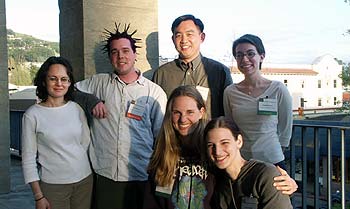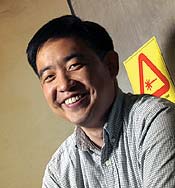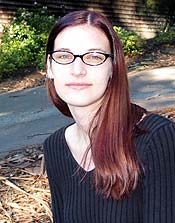 |
The new faces of nuclear engineering:
Conference organizers (clockwise from left) Elena Rodriguez-Vieitez,
David Barnes, Lance Kim, Amanda Johnsen, Darby Kimball, and Sarah Jockin (BAP photo) |
Student nuclear-engineering conference seeks to change attitudes in the nuke-free zone
The UC Berkeley ANS chapter organizers, who worked for two years to bring the conference to Berkeley, never tried to downplay the disconnect. For the conference's theme, they chose "Living in a Nuclear Free Zone," and they proudly feature the city of Berkeley's distinctive anti-nuke signs on the conference's Web site and program brochure.
 The student-designed brochure cover makes fun of the "hostile" territory the conference is being held in. |
An entire page of the brochure is devoted to reprinting the City of Berkeley's Municipal Code segment that codifies the "Nuclear Free Berkeley Act." The purpose of the 1986 act was to "to oppose the arms race by prohibiting work for nuclear weapons, to prohibit nuclear reactors, and to oppose the nuclear fuel cycle as a whole." The act cites the University of California system as a threat for its involvement in Lawrence Livermore and Los Alamos laboratories and demands that a nuclear reactor in Etcheverry Hall, home of UC Berkeley's nuclear engineering department, be removed. (It was.) Essentially, it's a manifesto against everything these students are planning to make their life's work.
"It's definitely ironic that we're holding this at the university where anti-nuke signs got their start," says Darby Kimball, a third-year Ph.D. candidate in nuclear engineering and as the Berkeley ANS chapter's current president, the conference's co-chair. "I'm sure that irony helped us in our application."
'Would Lend Socks To'
This is the first time in the student conference's 40-year history it has ever been held here, even though UC Berkeley's graduate program in engineering is one of the nation's most respected, ranked No. 2 by U.S. News and World Report's annual survey.
Lance Kim, who graduated from UC Berkeley's Nuclear Engineering department in 2002 (with its citation award) and is the conference's other co-chair, first decided to apply to bring the conference to Berkeley two years ago when he was still a student here. (He currently works for a government nuclear agency in Washington, DC; starting in June, he'll spend a year in Vienna, Austria at the International Atomic Energy Agency and then return to UC Berkeley for graduate school.) Kim says he got the idea while on the plane back from the successful 2001 conference hosted by Texas A&M.
"It was too late to apply that year, so we had to apply for this year," he says. He and the rest of the Berkeley ANS members faced tough opposition from four schools, including the Universities of Wisconsin and North Carolina, which had previously hosted conferences. About a year ago, they learned they'd won the event.
That's when the planning really started. "As the deadline looms, that's when the work grows exponentially," says Kimball. Nuclear engineering is the smallest engineering program at UC Berkeley, numbering only about 30 undergraduates and 40 graduates. The usual membership for the campus ANS chapter is about 12 students. By the time the conference started April 2, it had pulled in an additional 20 to help with the event logistics, including finding venues for the technical sessions, planning the social sessions, bringing in speakers, assembling employers for a career fair, and fundraising to help cover travel and housing grants for some of the student participants coming here from around the country. The Berkeley ANS chapter's irreverent sense of humor is evident from the program's list of sponsorship levels: ranging from "Jerk" ($1), "Good Buddy" ($500), "Would Lend Socks To" ($900) "Uncle Moneybags" ($5,000), and "Darby's Special Friend" - at $25,000, that one had no takers.
In addition for the chance to socialize with like-minded peers, the main reason students travel from around the country is to present their work to each other in technical sessions on topics like "Isotopes and Radiation II: Dosimetry and Shielding." "It can be pretty intimidating for the undergraduates to have to give a paper in front of a room full of graduate students," says Kimball, "but they know they'll need that experience for when they start attending professional conferences."
Margaret Mkhosi, a nuclear-engineering student from South Africa studying at Ohio State University, is in Berkeley to learn from others' presentation styles before she presents her own work (in the area of deposition of aerosols in pebble-bed modular reactors) at future conferences. Ohio State is looking for tips on hosting the ANS conference. "We want to observe and find out how Berkeley's students organized and planned this one," says Mkhosi.
Good nukes and bad nukes
In addition to a little nose-thumbing, the conference's theme of "Living in a Nuclear Free Zone" was intended to convey the organizers' goal of getting the industry to reach out to the public more, says Kimball.
So while four of the five main speakers are industry titans like Larry Foulke, a reactor physics consultant to Bechtel Bettis, Inc. and a former executive with Westinghouse Nuclear Energy systems, the organizers also invited Ruth Weiner, a senior member of the technical staff at Sandia National Laboratory and the author of two textbooks on environmental engineering and environmental pollution and control, to speak. They hoped that Weiner, a member of the Sierra Club for 25 years — including a period when the club was pro-nuclear energy, which it now adamantly opposes — would give an insider's perspective of the environmental activists' position on nuclear power.
 After winning the Nuclear Engineering Departmental Citation and graduating in May, conference chair Lance Kim is spending a few years working for government and nuclear regulatory agencies before returning to Berkeley for grad school. (Bart Nagel photo) |
Kim believes the biggest problem the nuclear engineering community faces is public relations. Most laypeople just don't understand what nuclear engineering is really about, he says. "They think I make bombs," he sniffs. He usually tries to enlighten those unfamiliar with the nuclear-energy industry with a few startling facts, such as: "There are more than 100 major nuclear energy plants in the United states, supplying 20 percent of our electricity," he reels off. "It's the second-largest electricity source after coal, which is extremely dirty environmentally. We also use nuclear plants to produce other sources of clean energy, like hydrogen."
To help would-be nuclear engineers deal with public perceptions, several workshop sessions focus on public education and the role that the media play in the nuclear industry. Others showcase ANS outreach projects like the Pennsylvania State chapter's work with the Girl Scouts and Boy Scouts. (The students helped the Boy Scouts get their atomic energy merit badges.)
Body-mod squad
It's customary for the ANS student conferences to offer tours of both local engineering facilities and local culture for visitors. The facilities component was easy: Kim and Kimball put together a hotly anticipated tour of Lawrence Livermore National Laboratory that includes a look at the brand-new gigantic laser that the National Ignition Facility uses for inertial fusion. Then, the conference-goer get to have lunch with Edward Teller, the 95-year-old "Father of the H-bomb."
On the cultural side, in addition to "Tourist Traps of San Francisco" and Napa Valley info sessions, Kim and Kimball decided to go for something a little spicier. One tour is called "Intro to Berzerkeley," a walking tour that culminates with a guided stroll down Telegraph Avenue, "home to the weirdest of the weird." There's also the "Body Modification Tour," in which the students will check out hair dyeing, piercing and tattoo salons. The conference brochure warns, "If you do not already have any body mods, we reserve the right to make you take the Intro to Berzerkeley Tour before joining us."
 Third-year graduate student Darby Kimball is the president of Berkeley's American Nuclear Society student chapter. She was featured in an episode of The Learning Channel's "Escape from Experiment Island," in which she had to build a car-powered boat. (Angela Privin photo) |
Kimball and Kim conceived the tours as a tongue-in-cheek response to the common stereotype of Berkeley. "I'm from the East Coast, so I was conscious of the political and social differences here," says Kimball. "People think of California and they think liberals, Berkeley and they think hippies. Berkeley students? Body modifications - like Dave over there." She points at graduate student David Barnes, the spiky-blue-haired and lip-ringed technical chair of the conference.
Most people, or at least this writer, wouldn't have guessed Barnes to be a nuclear engineering student. "You think we're too nerdy for that, don't you?" laughs Kim. "Well, I for one am." But Kimball is quick to point out that when UC Berkeley students did an informal survey of which major had the most average body modifications per person, nuclear engineering trumped political science for first place.
"Partly that was because we had a couple of people with 10 or more body mods each, and they've since graduated," says Kimball. She has a theory that may explain the rest. "Because nuclear energy has fallen so far out of favor with the culture as a whole, if you're the sort of person who has a technical bent to begin with but is looking for a way to be nonconformist, you choose nuclear engineering," she says. "You definitely get to stand out. Even at Berkeley, which is hard!"
A look round at the visiting students grazing at the welcome reception buffet confirms this theory. The room is divided between students who would not look out of place at MIT and those you might expect to find tossing a frisbee in the sun at People's Park in Berkeley.
Radioactivists
Being a nuclear engineer is a guaranteed conversation stopper, say these students. "When guys come up to me in a bar and ask me what my major is, they don't know what to say after I tell them," laughs Kimball. "Five minutes later they're across the room. I guess it just sounds too complicated and hard."
That explains why these nuclear engineering students look forward so much to socializing with each other at conferences like these. For the main social event, the Berkeley group has rented out the bottom floor of Blake's, a bar on Telegraph Avenue. There'll be a band as well as a deejay, a henna artist, and black lights to illuminate the drink specials with punny nuclear themes, like the "Three-Mile Island."
And so far, there have been no confrontations with local radicals or angry students waving no-nuke signs.
"I think we're slipping below people's radar because of war with Iraq," says Kim. "But even if people did protest, we would welcome that as a chance to explain what we're all about. It would give the students here some perspective. We missed out on the whole 1970s debate over nuclear energy, but that could be coming back around if the country does decide to build new plants to handle our energy needs."

